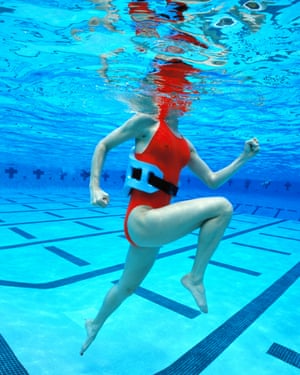Aquajogging: how, when and why to try it
Injuries happen to all runners regardless of age, ability or experience. Aquajogging, otherwise known as deepwater running, is a great way of staying fit while injured.
The double Olympic champion Kelly Holmes was an early proponent. In 2000, Holmes suffered a calf injury and could only resume track training six weeks before the Sydney Olympics, where she won the bronze medal. This remarkable achievement was made possible by her use of aquajogging to maintain an extremely high level of fitness as the injury healed.
So, if you have been sidelined by injury, fear not: it is possible to stay in shape. Even if you are not injured, aquajogging can be used to supplement your normal running programme and give your endurance a boost without giving your legs a pounding.
What is it?

Aquajogging involves wearing a flotation device around your middle and then moving your arms and legs in a running motion in the deep end of the pool. Your feet should not touch the floor of the pool and you should make slow forward progress. It is probably the most common form of cross training among elite athletes.
Aquajogging belts can be purchased cheaply online. Having the belt clipped on around your midriff allows you to stay afloat, so that your technique is focused on replicating a good running action, rather than keeping your head above water.
When performed right, with the correct upright posture, aquajogging is a great form of resistance training. Almost every muscle that you use when running can be exercised, and it is particularly beneficial for the hip flexors. Driving the knees up against the resistance of the water allows the hip flexors to be strengthened in a full range of motion. Hip flexors are chronically weak and tight in most runners who work desk jobs and spend most of the day sitting down. This weakness contributes to many running injuries; most commonly runner’s knee complaints. You may find that you have a better and more resilient running form back on dry land once you introduce aquajogging to your training programme.
Technique tips
- Ensure that the water in which you train is deep enough so your feet won’t hit the bottom when you run.
- Maintain an upright posture with shoulders directly above hips. The main conclusion from watching people aquajogging on an underwater camera is that, no matter how much you think you’re leaning back, you’re still leaning forward. This is probably because the belts give you more buoyancy at the back than front.
- Clench your hands in a fist so that you won’t “cheat” by swimming with your hands for forward propulsion.
- Imagine you are stepping over a barrel and rolling it behind you – ie exaggerate the knee drive over the imaginary barrel, and also push it back fully with the trail leg.
- Find a training partner. Without the distractions of the world passing you by, aquajogging alone can be quite dull.
- Always do intervals, always take short recoveries. Given that aquajogging is non-weight-bearing, the intensity will not be as high as with normal running. This should be countered by breaking each session up into intervals of hard effort with short recovery.
- Dorsiflex your feet – this is another thing you do while running on land without realising it, but you need to actively think about it when aquajogging – it means to pull your toes up towards your shins.
- Choose the slowest lane possible. Aquajogging is not intended to make you move fast through the water, so you will be going slower than everyone else in the pool.
- While the technical advice above is important to consider, the main thing to focus on is that you are working hard and getting your heart rate and breathing rate elevated.
There are of course many other forms of cross training, including swimming, cycling, elliptical and rowing machines. Aquajogging has the advantage of being zero-impact. This is particularly useful for runners who have suffered bad ankle or foot injuries, and for whom cycling and using an elliptical machine are thus not possible. Aquajogging has the benefits over swimming of not requiring any previous training and of working a more similar set of muscles to running.
Sessions
Below are some ideas for sessions that you can carry out in the pool, although replicating any of the training that you do in your normal running programme (with slightly reduced recoveries) will also work well.
Pool Session 1 (30min total, 14min hard)
- 8min easy warmup
- 8 x 1min hard (30sec recovery)
- 12 x 30sec hard (20sec recovery)
- 8min easy warmdown
Pool Session 2 (52min total, 22min hard)
- 10min warmup
- 3 x 3min hard (90sec recovery)
- 2min easy
- 4 x 2min hard (60sec recovery)
- 2min easy
- 5 x 1min hard (30sec recovery)
- 10min warmdown
Follow Jake on Twitter at @jakegshelley. He blogs at jakegshelley.wordpress.com.
Online coaching bigbeartc.org/coaching-packages.
Source: Read Full Article


